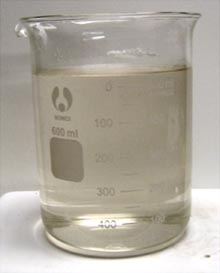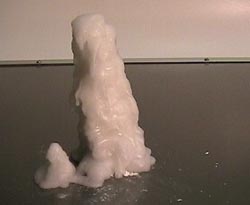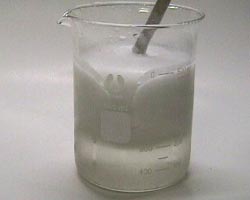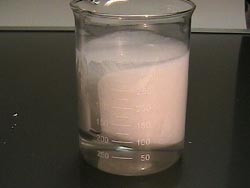Hot Ice
 Hot Ice refers to a chemistry demonstration involving a supersaturated solution of Sodium Acetate which, when disturbed, will appear to freeze into “ice” as the cold solution turns from a liquid into a solid in a matter of seconds. This process is exothermic and the resulting “ice” is warm to the touch, contrary to what one would expect of ordinary ice.
Hot Ice refers to a chemistry demonstration involving a supersaturated solution of Sodium Acetate which, when disturbed, will appear to freeze into “ice” as the cold solution turns from a liquid into a solid in a matter of seconds. This process is exothermic and the resulting “ice” is warm to the touch, contrary to what one would expect of ordinary ice.
The picture to the left depicts pillars of Sodium Acetate Trihydrate which were created using Hot Ice solution.
Supersaturated solutions of Sodium Acetate are used in certain types of hand-warmers. When a metallic button is pressed inside a plastic pouch, the supersaturated solution begins to crystallize, in the process releasing heat.
Sodium Acetate is one of the products of the reaction between baking soda (Sodium Bicarbonate, NaHCO3) and vinegar (Acetic acid, HC2H3O2).
The video below shows the Hot Ice phenomenon in action. In the video, a supersaturated solution of Sodium Acetate is carefully poured into an empty Petri dish and a small Sodium Acetate seed-crystal is dropped into the liquid. The seed-crystal triggers the “freezing” of the supersaturated solution and the liquid begins to crystallize. The crystallization expands outward from the seed crystal and quickly fills the entire Petri dish, converting all of the supersaturated Sodium Acetate solution into solid Sodium Acetate Trihydrate.
Video |
|---|
Making Hot Ice
In order to make Hot Ice, one must first create a supersaturated solution of Sodium Acetate.
At a given temperature, only a certain amount of Sodium Acetate will dissolve in a certain volume of water. When this amount of Sodium Acetate has been dissolved, the resulting solution is said to be saturated and no more Sodium Acetate will dissolve. In our case we are interested in making a supersaturated solution, meaning that we want to dissolve more Sodium Acetate in a certain volume of water than what is normally “allowed”.
How will we create a supersaturated solution if we are only allowed to dissolve a certain amount of Sodium Acetate? Remember that the saturation point changes with temperature. At higher temperatures more Sodium Acetate will dissolve, and at lower temperatures less Sodium Acetate will dissolve in a given volume of water. To create the supersaturated solution we need to raise the temperature of the water and dissolve as much Sodium Acetate as we can (saturate the solution). Afterward, we allow the solution to cool back down to room temperature and then cool it even further in a refrigerator. As the solution’s temperature drops, the solubility of the Sodium Acetate will decrease as well. If the cooling process is done carefully enough then the excess Sodium Acetate which is dissolved in solution will stay dissolved even though the water is already fully saturated at its current temperature. In order for this to occur, the container must be very clean and smooth, free from dust and undissolved Sodium Acetate crystals, and the solution should be kept calm (do not shake it around) as it gradually cools. When done properly, the hot, saturated, Sodium Acetate solution should cool and become supersaturated without any Sodium Acetate precipitating out of solution.
|
Creating a supersaturate solution using anhydrous Sodium Acetate (NaC2H3O2) and water can sometimes be difficult when trying to dissolve just the right amount of Sodium Acetate in water. An easier option exists using Sodium Acetate Trihydrate (NaC2H3O2 • 3 H2O) in place of the anhydrous variety. Sodium Acetate Trihydrate has 3 water molecules bound within its crystal lattice for every formula unit of Sodium Acetate…the water is already there, there is no need to add more. Sodium Acetate Trihydrate has the nice property of ‘melting’ at the very moderate temperature of only 58 °C (about 136 °F). Of course, the Sodium Acetate Trihydrare is not really melting, it is actually dissolving in the water which was bound within its own crystal lattice. By heating some “dry” (or at least it appears dry) Sodium Acetate Trihydrate, one will create an ideal solution with which to make Hot Ice. When heating the Sodium Acetate Trihydrate, take care not to use too high of a setting on the hot plate / stove / oven since one might inadvertently evaporate off too much of the water and the Sodium Acetate will no longer be in the proper ratio with water in the solution. Once all the Sodium Acetate Trihydrate has melted / dissolved, allow the solution to cool inside a refrigerator so that it will reach the point of supersaturation.
It is recommended that after one prepares the (hot) saturated Sodium Acetate solution, one should carefully poor the solution into a clean, smoothed-walled, container and use this new container when cooling and storing the Hot Ice solution. The point of doing this is that it lowers the risk of setting off the Hot Ice prematurely. Any tiny, undissolved, crystals remaining in the solution or along the walls of the container might trigger the Hot Ice to solidify. Therefore, it is best to let any undissolved Sodium Acetate settle the bottom of the original container before carefully pouring the solution into the new container, being careful not to splash any droplets onto the inside wall of the new container.
Once the Sodium Acetate solution has become supersaturated the Hot Ice is ready to use. By sufficiently disturbing the solution (for example, by touching it or by adding a seed-crystal to the supersaturated solution) the Hot Ice crystals will begin to form and spread throughout the container.
Afterward, one can re-use the solid Sodium Acetate Trihydrate again and again. Simply heat the crystals up past their melting point in order to re-dissolve the Sodium Acetate and then cool the liquid to create the supersaturated solution.
Videos
Below:
A supersaturated solution of Sodium Acetate is slowly poured out onto a few small Sodium Acetate seed crystals placed on an otherwise smooth surface. Upon contact with the surface and the seed crystals, the supersaturated solution immediately begins to crystallize, forming pillars of Sodium Acetate Trihydrate.
Video |
|---|
Below:
(Top Video) A wooden dowel coated with Sodium Acetate, and (Bottom Video) a small Sodium Acetate seed crystal trigger the supersaturated Hot Ice solution contained within the beaker. Quickly, the entire solution crystallizes and the beaker is filled with Sodium Acetate Trihydrate. In the bottom video, an infrared thermometer is used to measure the initial and final temperatures of the beaker, showing a change in temperature from about 10 °C to about 37 °C.
Video |
|---|
What is happening?
 Since supersaturated solutions contain more dissolved solute than would normally exist in equilibrium they exist in a meta-stable state, similar to that of a ball sitting at the apex of a steep mountain. As long as nothing happens to the solution, like the ball sitting precariously atop the mountain, it will continue on in that state. However, the slightest “nudge” in any direction and the supersaturated solution (and the ball) will try to restore itself to its most stable state by precipitating solute out of solution (or rolling down to the bottom of the mountain in the case of the ball).
Since supersaturated solutions contain more dissolved solute than would normally exist in equilibrium they exist in a meta-stable state, similar to that of a ball sitting at the apex of a steep mountain. As long as nothing happens to the solution, like the ball sitting precariously atop the mountain, it will continue on in that state. However, the slightest “nudge” in any direction and the supersaturated solution (and the ball) will try to restore itself to its most stable state by precipitating solute out of solution (or rolling down to the bottom of the mountain in the case of the ball).
When the Hot Ice solution is triggered (possibly by the addition of a seed crystal), the dissolved Sodium Acetate comes out of solution and returns to a solid form. Furthermore, the solid Sodium Acetate can absorb water into its crystal lattice, becoming Sodium Acetate Trihydrate (NaC2H3O2 ● 3 H2O) in the process. The hydration of Sodium Acetate is exothermic and heat is released in the process, explaining why the Sodium Acetate crystals are warm even though the supersaturated solution was initially cold.
Last updated:
01/11/2008








